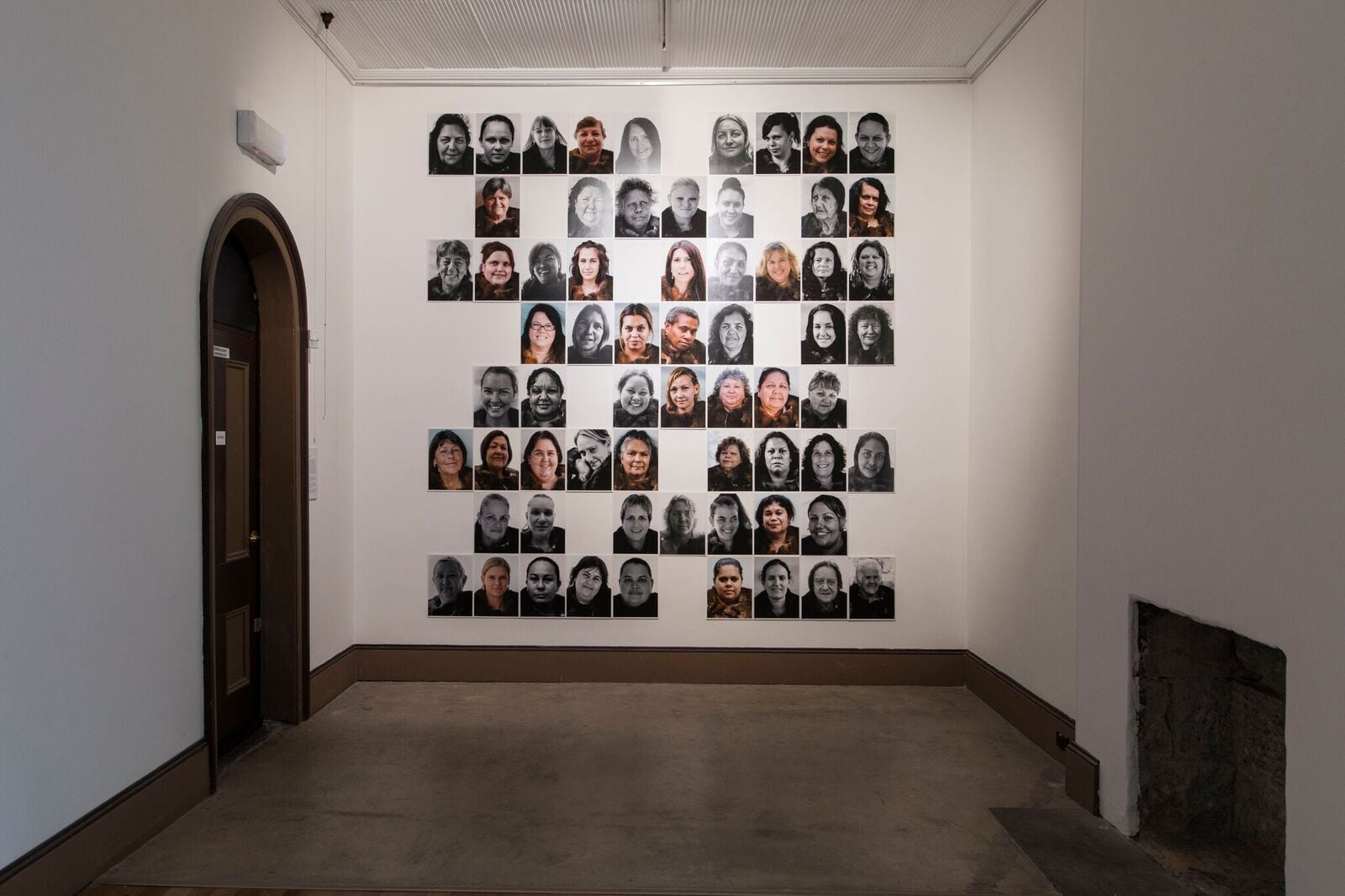

Artists: Billy & Lulu Cooley, Jason Couthard, Ruby Djikarra Alderton, Cherie Johnson, Nicole Monks, David Leha, Steaphan Paton, Vicki West.
Curator: Cherie Johnson
Australian contemporary art – if we can be so bold as to make it a unifying concept – has never been more pluralistic nor more self-consciously attuned to cultural, social, political, economic and environmental issues. If there’s a moral hegemony in exhibitions of contemporary art, it is the voice of Indigenous Australia. And this is where we need to be, 229 years into our collective shotgun marriage. Just as the enduring flame of Indigenous land, lore and language is the country’s undisputed foundational narrative, the cataclysm of colonisation is the secondary script against which Aboriginal and Torres Strait Islander artists are continually improvising.
Transmission is a perfectly honed exemplar of this ongoing project, a passionately staked claim quietly triumphant in its aesthetic reserve. Curator and artist Cherie Johnson has woven together themes of cultural revivalism, community collaborations and interdisciplinary practice to show that transmitting culture – down the ancestral line and outward to immediate communities and the world – is a unifying feature of contemporary Indigenous tradition. A real strength is the line-up of lesser known artists alongside more established practitioners thereby avoiding the pitfall of exhibitions that draw repeatedly on the same gene pool.
Sharing conceptual ground with Sovereignty at Melbourne’s ACCA, Transmission responds to local particulars. If William Barak’s historical and political legacy framed the Melbourne show, in Transmission colonial history rests in the very fabric of the exhibition building, a heritage listed police station operational from 1861-1982 thick with the ghosts of incarceration. A site of trauma and Newcastle’s premier contemporary art space, The Lock-Up presents a paradox well tested in Director Jessi England’s programming. To this end, Transmission has ambitions that were further explored in the accompanying public symposium: What is contemporary Aboriginal Art? What is culturally appropriate? What is cultural appropriation? Who has authority to determine the answers to these questions?
The first might seem redundant by 2017, because it is the only question easily answered. Curators, artists and critics frequently use media as an index of culture and a sign of contemporaneity in efforts to expand conventional ideas of what constitutes Aboriginal art, and Transmission does the same. The other issues posed by Transmission are more complex. In a week that saw Namatjira’s copyright finally returned to his family, the symposium discussions focused on repatriation, language revival, intellectual property rights and the failure of Australian copyright law to prevent pastiche ‘fake art’ souvenirs flooding the market from overseas. This irony was not lost on exhibitor Ruby Djikarra Alderton, a Newcastle based Yolngu artist whose family – the Marika dynasty from Yirrkala – were instrumental campaigners for Aboriginal artists’ legal copyright protection.
Establishing ‘cultural appropriateness’ and ‘cultural appropriation’ is an ongoing project, and obtaining ‘permission’ is a case-by-case affair. While non-Indigenous artists earnestly seek ‘appropriate’ ways to engage with Indigenous art and artists, Aboriginal artists and communities are also striving to work within culturally, regionally and individually appropriate terms. Negotiations are the only constant and they are not confined to the present: gut feeling or ancestral communions, such powers of authority were cited as guiding principles by several Transmission artists.
An ongoing project by Johnson makes this point better than words can. In 2014, mentored by Victoria’s possum-skin matriarch Vicki Couzens, Johnson initiated Wrapture, inviting eighty women across the Hunter Region to explore cultural identity through possum skin cloaks. First exhibited at The University of Newcastle (where Johnson is a PhD candidate), her photographs capture the moment of connection when the women wear possum skin for the first time. In Transmission, the candid colour and black and white portraits form an incomplete grid, the blanks representing those women who, for a variety of personal reasons, declined to wear the possum skins. Taking this relational expression of cultural revival further, Wrapture’d (2017) is a triptych of baby-sized possum skin cloaks made with three pregnant women in anticipation of their babies; each layette remains unmarked as the families establish appropriate motifs, however the third plinth remains empty, representing the incomplete negotiations of the expectant mother and demonstrating that ‘not all Aboriginal practices are for all Aboriginal people,’ a mantra that Johnson, as cultural facilitator and educator, upholds across all her work.
Channelling the cadence of country from afar is another theme in Transmission. In the dark cell-blocks of The Lock-Up, Alderton’s coloured etching of the water rarrk of her mother’s Rirratjingu clan evoked tropical waters, David Leha’s Gamilaraay sound-piece warms the stonework and Newcastle based Jason Coulthard’s shape-shifting digital projections summon his Adnyamathanha law-keepers. The cells also house moving image works by Nicole Monks – the uninterpretable and therefore compelling Belonging, not Belonging (2016) – and the unequivocal Cloaked Combat #3 (2013) video/performance piece by Steaphan Paton.
Transmission opened with Awabakal Elder Sandra Griffin’s Welcome to Country and Wirrigan Elder Bill Smith’s smoking ceremony during which he invited guests to hug their neighbour, “tell ‘im you love ‘im”, introduce yourself to the room and “tell us where y’ from”, a cue to declare ancestries. Performed with humour and inclusiveness, the ritual was a reminder that we are all shaped by multiple origins and a lifetime of transitions. Decolonising is one word for it, but as Transmission reveals, a youthful cohort from across Australia have occupied The Lock-Up – and they’ve done it with authority.
Una Rey is an artist and lecturer in the School of Creative Industries, The University of Newcastle. In 2016 she curated Black White & Restive: cross-cultural initiatives in Australian contemporary art at Newcastle Art Gallery.
